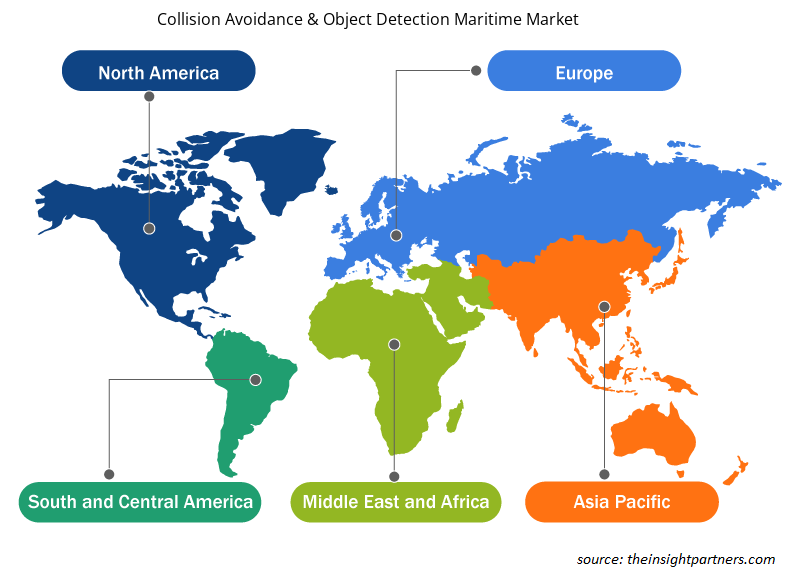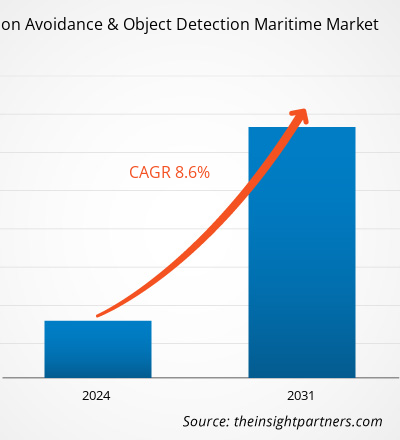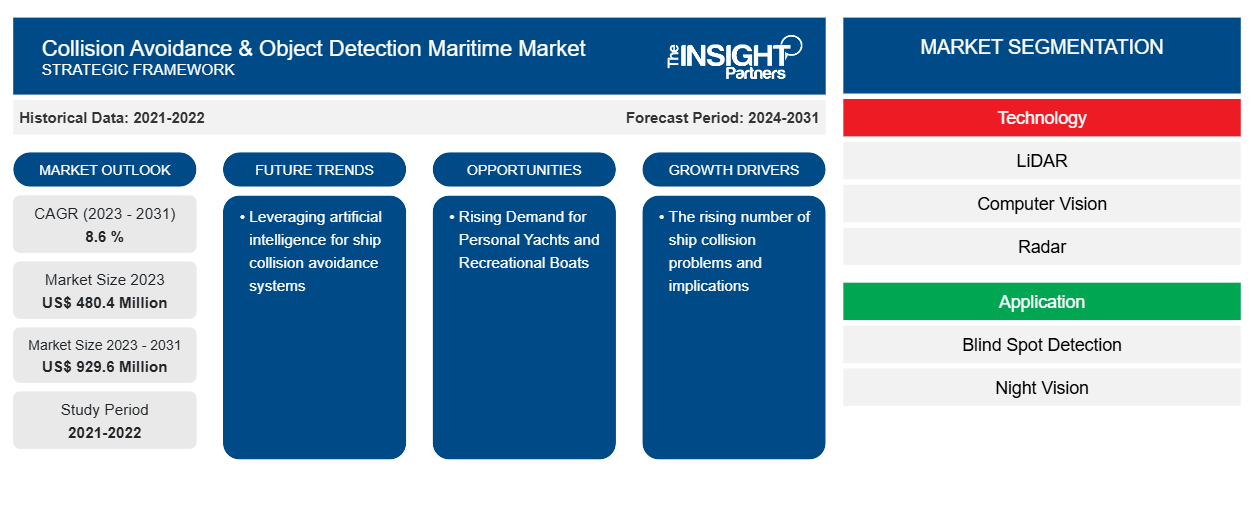Se prevé que el tamaño del mercado marítimo de prevención de colisiones y detección de objetos alcance los 929,6 millones de dólares en 2031, frente a los 480,4 millones de dólares en 2023. Se espera que el mercado registre una CAGR del 8,6 % durante el período 2023-2031. Es probable que el aprovechamiento de la inteligencia artificial para los sistemas de prevención de colisiones de barcos siga siendo una tendencia clave en el mercado.
Análisis del mercado marítimo de detección de objetos y prevención de colisiones
Los sistemas de prevención de colisiones en operaciones marítimas se basan en ayudas y normas de navegación establecidas para evitar colisiones de buques y sirven como base para la seguridad marítima. El radar, el ECDIS, el ARPA, el VTS y las luces y marcas de navegación se han utilizado durante bastante tiempo y han demostrado ser confiables durante muchos años de uso real en una variedad de condiciones marítimas. Algunas de las características más notables de estos sistemas de prevención de colisiones de buques incluyen información de alcance y rumbo, funcionalidad interconectada, sistemas de alarma y advertencia, y otras.
Descripción general del mercado marítimo de detección de objetos y prevención de colisiones
Los accidentes de buques siguen siendo un problema crítico en la industria marítima, ya que plantean graves riesgos para los buques, el medio ambiente y la seguridad de las personas. El enorme crecimiento del tráfico marítimo mundial, junto con la creciente congestión en las principales vías navegables, ha aumentado la posibilidad de que se produzcan estos accidentes. Para mitigar estos peligros, la inteligencia artificial (IA) y los sistemas de prevención de colisiones de buques basados en visión artificial (VCAS) han surgido como técnicas fundamentales para evitar obstáculos. Estos sistemas utilizan visión artificial y fusión de sensores las 24 horas del día, los 7 días de la semana, para analizar los peligros en tiempo real, lo que supone una importante contribución a la seguridad marítima.
Personalice este informe según sus necesidades
Obtendrá personalización en cualquier informe, sin cargo, incluidas partes de este informe o análisis a nivel de país, paquete de datos de Excel, así como también grandes ofertas y descuentos para empresas emergentes y universidades.
-
Obtenga las principales tendencias clave del mercado de este informe.Esta muestra GRATUITA incluirá análisis de datos, desde tendencias del mercado hasta estimaciones y pronósticos.
Factores impulsores y oportunidades del mercado marítimo en materia de prevención de colisiones y detección de objetos
Aumento del número de colisiones de buques y sus consecuencias para el mercado
Los accidentes de buques siguen siendo un problema importante en la industria marítima, con efectos de gran alcance. El informe Annual Overview of Marine Casualties and Occurrences in 2023 de la Agencia Europea de Seguridad Marítima informa que cada año ocurren aproximadamente 4000 incidentes relacionados con la seguridad. Si bien esta cifra indica una disminución de los eventos en comparación con años anteriores, también enfatiza la persistencia del problema. Cada año, estas colisiones cuestan a la industria marítima aproximadamente 20 mil millones de dólares en daños, tiempos de inactividad prolongados para reparaciones, degradación ambiental, interrupciones en la cadena de suministro, incidentes de salud y seguridad de la tripulación y erosión de la confianza entre las partes interesadas corporativas con un fuerte interés en la gente de mar. Los accidentes de buques son causados por una variedad de circunstancias, incluidos errores humanos, fallas de maquinaria y malas condiciones climáticas. Un considerable cuerpo de investigación respalda el error humano como la principal causa de los accidentes marítimos. Entre 2014 y 2022, las investigaciones de seguridad encontraron que el 59,1% de los incidentes de accidentes fueron causados por la actividad humana, y el 50,1% de las variables contribuyentes estaban vinculadas al comportamiento humano. Si se incluyen tanto los eventos de acción humana como los elementos que contribuyen a la conducta humana, el factor humano representó un increíble 80,7% de los accidentes e incidentes marítimos estudiados durante este período. El exceso de confianza, la imprudencia en la respuesta a las presiones comerciales, el cansancio y la falta de la experiencia y la comunicación necesarias se han identificado como las principales causas de la evitación adecuada de barreras. Para evitar colisiones entre buques, los sistemas marítimos se basan en ayudas y normas de navegación establecidas para prevenir colisiones de buques y crear las bases de la seguridad marítima.
Creciente demanda de yates personales y embarcaciones recreativas
Los yates, que tradicionalmente se asocian con el lujo y la indulgencia, se están volviendo más populares como vehículos de inversión. Más allá del lujo que representan, los yates brindan una oportunidad financiera única que se extiende más allá del horizonte. Invertir en un yate va más allá de la definición tradicional de activos financieros. Es una inversión en un estilo de vida, estatus y la posibilidad de obtener ganancias financieras. Con la técnica correcta, los yates pueden brindar una combinación de diversión y ganancias, lo que los convierte en una opción atractiva para las personas que buscan navegar en los mares de las finanzas con estilo y sofisticación. Además, los barcos recreativos son una alternativa popular para cualquiera que quiera pasar horas tranquilas en el agua. Estos barcos son embarcaciones capaces de una navegación activa autopropulsada y se utilizan principalmente para recreación, pesca o usos comerciales. Debido a esto, la demanda de yates personales y barcos recreativos está aumentando; por lo tanto, el creciente número de estos barcos está creando demanda para el crecimiento del mercado marítimo de prevención de colisiones y detección de objetos.yachters and recreational boats is increasing; thus, the growing number of these boats is creating demand for the growth of the collision avoidance & object detection maritime market.
Informe de mercado marítimo de detección de objetos y prevención de colisiones: análisis de segmentación
Los segmentos clave que contribuyeron a la derivación del análisis del mercado marítimo de prevención de colisiones y detección de objetos son tecnología, aplicación, aplicación y sector.
- Basado en la tecnología, el mercado marítimo de prevención de colisiones y detección de objetos está segmentado en LiDAR, visión por computadora, radar y otros.LiDAR, computer vision, radar, and others.
- Según la aplicación, el mercado marítimo de prevención de colisiones y detección de objetos se segmenta en detección de puntos ciegos, visión nocturna y otros.
- Según el usuario final, el mercado marítimo de prevención de colisiones y detección de objetos se segmenta en vehículos de superficie no tripulados, barcos y vehículos submarinos autónomos.
Análisis de la cuota de mercado de los sistemas de detección de objetos y prevención de colisiones en el sector marítimo por geografía
El alcance geográfico del informe del mercado marítimo de detección de objetos y prevención de colisiones se divide principalmente en cinco regiones: América del Norte, Asia Pacífico, Europa, Oriente Medio y África, y América del Sur y Central. Se prevé que las exportaciones de Asia Pacífico aumenten rápidamente, ayudadas por el continuo y sólido desarrollo del comercio intrarregional dentro de Asia Pacífico, ya que China, India y la ASEAN siguen estando entre los mercados emergentes de más rápido crecimiento del mundo. Singapur marítimo alberga casi 5000 establecimientos marítimos y 140 de las principales empresas navieras internacionales del mundo, incluidas la gestión de barcos, la agencia, las finanzas, los seguros, el corretaje y la topografía. La industria sustenta a 160.000 personas. Por lo tanto, la presencia de dichas empresas navieras internacionales y destinos de exportación crea una oportunidad para el crecimiento del mercado marítimo de detección de objetos y prevención de colisiones.intra-regional commerce within Asia Pacific, as China, India, and ASEAN remain among the world's fastest-growing emerging markets. Maritime Singapore is home to almost 5,000 maritime establishments and 140 of the world's leading international shipping firms, including ship management, agency, finance, insurance, broking, and surveying. The industry supports 160,000 people. Thus, the presence of such international shipping firms and export destinations creates an opportunity for the growth of the collision avoidance & object detection maritime market.
Prevención de colisiones y detección de objetos marítimos
Perspectivas regionales del mercado marítimo de detección de objetos y prevención de colisiones
Los analistas de Insight Partners explicaron en detalle las tendencias y los factores regionales que influyen en el mercado marítimo de detección de objetos y prevención de colisiones durante el período de pronóstico. Esta sección también analiza los segmentos y la geografía del mercado marítimo de detección de objetos y prevención de colisiones en América del Norte, Europa, Asia Pacífico, Oriente Medio y África, y América del Sur y Central.

- Obtenga datos regionales específicos para el mercado marítimo de detección de objetos y prevención de colisiones
Alcance del informe sobre el mercado marítimo de detección de objetos y prevención de colisiones
| Atributo del informe | Detalles |
|---|---|
| Tamaño del mercado en 2023 | US$ 480,4 millones |
| Tamaño del mercado en 2031 | US$ 929,6 millones |
| CAGR global (2023 - 2031) | 8,6 % |
| Datos históricos | 2021-2022 |
| Período de pronóstico | 2024-2031 |
| Segmentos cubiertos |
Por tecnología
|
| Regiones y países cubiertos |
América del norte
|
| Líderes del mercado y perfiles de empresas clave |
|
Densidad de actores del mercado marítimo en prevención de colisiones y detección de objetos: comprensión de su impacto en la dinámica empresarial
El mercado marítimo de detección de objetos y prevención de colisiones está creciendo rápidamente, impulsado por la creciente demanda de los usuarios finales debido a factores como la evolución de las preferencias de los consumidores, los avances tecnológicos y una mayor conciencia de los beneficios del producto. A medida que aumenta la demanda, las empresas amplían sus ofertas, innovan para satisfacer las necesidades de los consumidores y aprovechan las tendencias emergentes, lo que impulsa aún más el crecimiento del mercado.
La densidad de actores del mercado se refiere a la distribución de las empresas o firmas que operan dentro de un mercado o industria en particular. Indica cuántos competidores (actores del mercado) están presentes en un espacio de mercado determinado en relación con su tamaño o valor total de mercado.
Las principales empresas que operan en el mercado marítimo de prevención de colisiones y detección de objetos son:
- Benewake (Pekín) Co. Ltd.
- Productos Orlaco BV
- Protección contra incendios Raytheon GmbH
- Garmin Ltd
- Máquinas marinas robóticas inc.
- Robopec SAS
Descargo de responsabilidad : Las empresas enumeradas anteriormente no están clasificadas en ningún orden particular.

- Obtenga una descripción general de los principales actores clave del mercado marítimo de detección de objetos y prevención de colisiones
Noticias y desarrollos recientes del mercado marítimo de detección de objetos y prevención de colisiones
El mercado marítimo de detección de objetos y prevención de colisiones se evalúa mediante la recopilación de datos cualitativos y cuantitativos posteriores a la investigación primaria y secundaria, que incluye publicaciones corporativas importantes, datos de asociaciones y bases de datos. A continuación, se enumeran algunos de los avances en el mercado marítimo de detección de objetos y prevención de colisiones:
- Garmin International, Inc., una división de Garmin Ltd., colaboró con Sea Tow Services, International, Inc., que ofrecerá a los operadores de franquicias y a los miembros ofertas exclusivas y capacitación sobre productos para mejorar la seguridad de los navegantes. Estas alianzas estratégicas con proveedores internacionales de asistencia marítima brindarán a los miembros capacitación de Garmin para mejorar la seguridad.
(Fuente: Garmin Ltd, junio de 2022)
- Velodyne Lidar, Inc. anunció que Seabed BV se especializa en equipos de alta calidad para dragado y prospección en alta mar y ha seleccionado sensores Puck para su sistema de mapeo móvil lidar. El sistema Seabed es una solución lidar móvil llave en mano para prospecciones hidrográficas que puede ayudar en la planificación sustentable y la protección de entornos históricos y marinos sensibles.
(Fuente: Velodyne Lidar, Inc., junio de 2021)
Informe sobre el mercado marítimo de detección de objetos y prevención de colisiones: cobertura y resultados
El informe “Tamaño y pronóstico del mercado marítimo de detección de objetos y prevención de colisiones (2021-2031)” proporciona un análisis detallado del mercado que cubre las siguientes áreas:
- Tamaño y pronóstico del mercado marítimo de prevención de colisiones y detección de objetos a nivel mundial, regional y nacional para todos los segmentos clave del mercado cubiertos por el alcance
- Tendencias del mercado marítimo de detección de objetos y prevención de colisiones, así como dinámicas del mercado, como impulsores, restricciones y oportunidades clave
- Análisis detallado de las cinco fuerzas de Porter y PEST y FODA
- Análisis del mercado marítimo de prevención de colisiones y detección de objetos que abarca las tendencias clave del mercado, el marco global y regional, los principales actores, las regulaciones y los desarrollos recientes del mercado
- Análisis del panorama de la industria y de la competencia que abarca la concentración del mercado, el análisis de mapas de calor, los actores destacados y los desarrollos recientes para el mercado marítimo de detección de objetos y prevención de colisiones
- Perfiles detallados de empresas
- Análisis histórico (2 años), año base, pronóstico (7 años) con CAGR
- Análisis PEST y FODA
- Tamaño del mercado, valor/volumen: global, regional y nacional
- Industria y panorama competitivo
- Conjunto de datos de Excel
Informes recientes
Testimonios
Razón para comprar
- Toma de decisiones informada
- Comprensión de la dinámica del mercado
- Análisis competitivo
- Información sobre clientes
- Pronósticos del mercado
- Mitigación de riesgos
- Planificación estratégica
- Justificación de la inversión
- Identificación de mercados emergentes
- Mejora de las estrategias de marketing
- Impulso de la eficiencia operativa
- Alineación con las tendencias regulatorias























 Obtenga una muestra gratuita para - Mercado marítimo de prevención de colisiones y detección de objetos
Obtenga una muestra gratuita para - Mercado marítimo de prevención de colisiones y detección de objetos